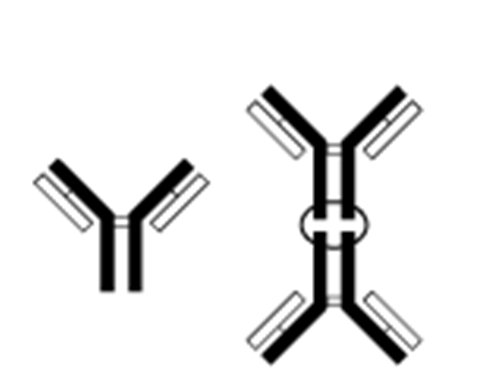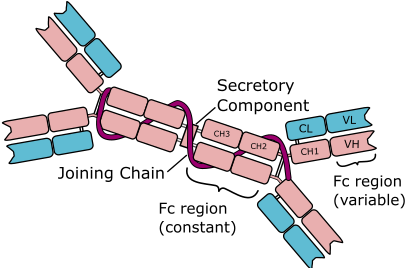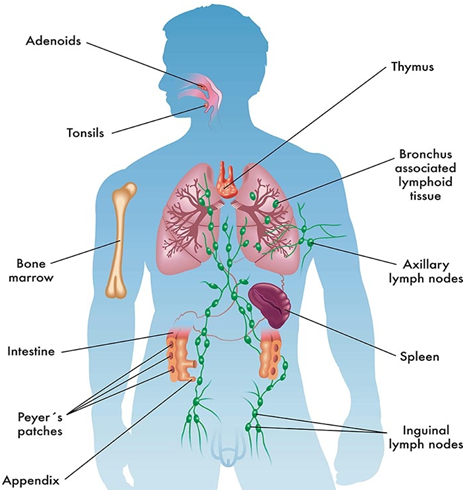Immunoglobulin A (IgA) is an antibody found in serum (as a monomer of about 150,000 Daltons) and in body secretions (as a dimer of about 600,000 Daltons); and it is mainly produced in the body by mucosal associated lymphoid tissue (MALT). Though it mainly exists as a monomer and dimer (Figure 1) IgA can also exist in polymeric forms. It is mainly found in external mucosal secretions of the body such as in the secretions of the GIT, lungs or bronchial secretions and the genitor-urinary tract.
Saliva, tears, colostrum or breast milk, sweat and nasal fluids are other external body secretions in which IgA is found. The immunoglobulin A of external body secretions (e.g. saliva, tears and breast milk) is generally known as secretory immunoglobulin A (sIgA). sIgA is produced mainly by epithelial cells of secretory membranes.
They are usually the first line of defense against pathogenic microorganisms (inclusive of bacteria and viruses) that invade the mucosal surfaces of the body. For example, the mucous membrane surfaces especially those found in the nasal areas, GIT, genitor-urinary tract, mouth and eye region are usually the main portal of entry of some disease-causing agents such as bacterial and viral pathogens.
The main biological function of sIgA at these mucosal surfaces is to prevent the attachment of pathogens to the mucosal surfaces by specifically binding to viral and bacterial surfaces antigens. After binding, the mucous entraps the IgA-antigen complex formed; and this complex is later eliminated from the body via the ciliated epithelial cells and peristalsis mechanisms found in these mucosal surfaces.
At the mucosal surfaces, sIgA and IgA in general prevents the adherence of coated pathogenic microorganisms (e.g. bacteria and viruses) to the surfaces of mucosal cells, and thus prevent their entry into internal body tissues and into the circulatory system. IgA does not cross the placenta and it activates the complement system only via the alternative pathway.

The illustration on the right-hand side is a schema of secretory IgA (sIgA), a dimer; and it is usually found in external body fluids or secretions such as breast milk and saliva and other internal body fluids. Immunoglobulin A protects mucosal surfaces of the body; and sIgA is the main antibody found in external secretions such as intestinal mucous, tears, saliva and respiratory and genitor-urinary tract fluids. Immunoglobulin A is also the main protective antibody in the breast milk (e.g. colostrum) of infants where it provides a passive type of immunity.
REFERENCES
Abbas A.K, Lichtman A.H and Pillai S (2010). Cellular and Molecular Immunology. Sixth edition. Saunders Elsevier Inc, USA.
Actor J (2014). Introductory Immunology. First edition. Academic Press, USA.
Alberts B, Bray D, Johnson A, Lewis J, Raff M, Roberts K and Walter P (1998). Essential Cell Biology: An Introduction to the Molecular Biology of the Cell. Third edition. Garland Publishing Inc., New York.
Bach F and Sachs D (1987). Transplantation immunology. N. Engl. J. Med. 317(8):402-409.
Barrett J.T (1998). Microbiology and Immunology Concepts. Philadelphia, PA: Lippincott-Raven Publishers. USA.
Jaypal V (2007). Fundamentals of Medical Immunology. First edition. Jaypee Brothers Medical Publishers (P) Ltd, New Delhi, India.
John T.J and Samuel R (2000). Herd Immunity and Herd Effect: New Insights and Definitions. European Journal of Epidemiology, 16:601-606.
Levinson W (2010). Review of Medical Microbiology and Immunology. Twelfth edition. The McGraw-Hill Companies, USA.
Roitt I, Brostoff J and Male D (2001). Immunology. Sixth edition. Harcourt Publishers Limited, Spain.
Zon LI (1995). Developmental biology of hematopoiesis. Blood, 86(8): 2876–91.
Discover more from #1 Microbiology Resource Hub
Subscribe to get the latest posts to your email.



